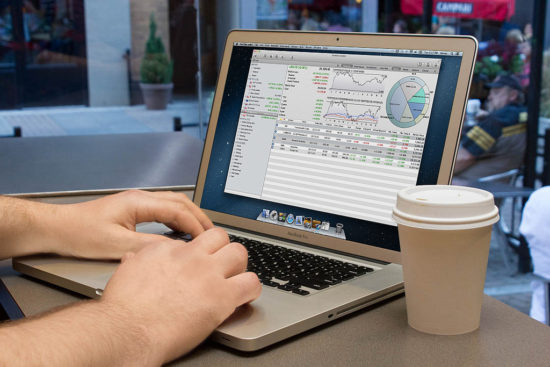
Ah, the stock market: it makes millionaires and even billionaires in good times – and it can ruin fortunes in bad times. More important than havinggood times or bad times, though, is knowing what to do at all times. After all, month in and month out, the markets just trudge along making money for some and losing money for others. There is a common misconception that trading is a gamble and has to do with luck. But winning or losing is mostly a function of knowledge, strategy and execution.
If you’re considering trading stocks, you’re in for a fascinating ride no matter what the markets are doing. The stock market drives the world economy and provides a primary investment tool for millions of people worldwide.
Basics for Beginners
If you’re brand-new to stock trading, it helps to be clear on what the stock market is and how to trade it.
To buy and sell stocks, you’ll open a brokerage account. That account will give you access to thousands of stocks that you can buy and sell (the stocks are listed on exchanges like the New York Stock Exchange (NYSE) and NASDAQ.) When you buy stock, you actually own a small part of the company. That’s why you’ll often hear that a company’s management “answers to the stockholders” – the shareholders own the company in a collective sense.
You can also buy Exchange Traded Funds (ETFs) which are similar to mutual funds except they can be bought and sold in real time just like stocks. You can buy the entire S&P 500 index, for example, by just buying shares of SPY – an ETF that mirrors the performance of the S&P 500.
How Much Money Do You Need?
This is the first and fundamental question before you begin, and it should be carefully considered. You don’t want to invest your rent money in the market, for example. It helps to look at the concept of “money” from several perspectives:
- Net worth – this is the overall number you get when you add up all your assets and subtract all your liabilities. If you’re curious, you can use an online calculator or consult a financial advisor or accountant. If you have a negative net worth, especially if it’s substantially negative, you might consider getting out of debt before investing in the stock market.
- Liquid net worth – this is, essentially, the amount of cash available to you. Once you factor out money that you don’t have immediate access to, like the net value of your cars, home, retirement accounts etc., it tells you how much money you have to play with.
- Risk capital – this is a portion of your available cash. For many people, liquid net worth and risk capital can be the same thing. It’s advisable, however, to maintain reserve cash accounts separate from risk capital. This might include savings for emergencies, college funds, vacation funds etc.
For most people, it is wise to trade the stock market only with risk capital. It’s important to make sure you’re not putting more money in the market than is prudent for you. The stock market, after all, does involve risk.
There are exceptions to this – a college fund, for example. Since a college fund is usually a growth investment that builds up for years before you start using it, the stock market can be a great way to invest that money. In general, though, you want quick-access money like emergency funds and vacation funds separate from your stock market activity.
A financial advisor can help you evaluate all these considerations, and help you get clear on where you stand.
$5,000 is a reasonable minimum amount of risk capital to trade the stock market, although $10,000 or more is preferable.
Trading vs. Investing
The next thing to think about is your high-level strategy. Will you be a trader or an investor?
Trading is a short-term strategy. You buy a stock, hold it for a short period of time and then sell it. Traders usually try to ride a short move and then get out quickly – sometimes a day or two, sometimes a week or two, sometimes a few months, or even “day trading,” through which you are in and out in the same day, sometimes minutes.
One note about day trading is that it’s best to have at least $25,000 to day-trade stocks in the US. Anything less than that can hamper your ability to day trade legally, since an account smaller than $25,000 is limited to three “day-trades” every five days with US brokers. It is possible to open accounts with offshore brokers, but the safest option is to keep your account within borders, which restricts US traders to what is known as the PDT rule.
Investing is a long-term strategy. You buy a stock and hold it, often for many years. Most long-term investors prefer stocks that pay dividends to supplement the growth in share value. Generally speaking, this kind of investing works best with larger amounts of capital like $100,000 or more.
A skilled trader can make substantially better returns than an investor. The markets move up and down in cycles during a year, and an adept trader can learn to strategically trade the ups and downs for maximum gain. While it’s true that trading can involve greater risk, there are technical strategies that can minimize risk. A well-educated trader can have substantial advantages in the market.
Note: as your capital grows, you can do both trading and investing. Short-term trading can help boost your income, and long-term investing can grow your wealth for retirement and college savings. Sophisticated traders often use this approach to combine the best of both strategies.
Self-Directed Trading or Full-Service Broker?
The next big question is: will you do your own trading or will you use a full-service broker who manages your trades?
If you’ve chosen a trading strategy rather than an investing strategy, you definitely want an online broker. Full-service brokers that manage your trades are only well suited to buy-and-hold investing.
Online brokers come in all shapes and sizes, and there are many great ones to choose from. Here are a few of the key considerations you’ll want to look into:
- Commissions – lower commissions can make a big difference if you’re an active trader. You pay a commission when you buy and another commission when you sell. Over the course of many trades, lower commissions will add up over the course of a year. $5 to $8 commissions are common, with some brokers offering volume discounts, and you shouldn’t have to pay more than $10.
- Trading platform – the online interface that you used to execute trades varies dramatically from broker to broker. It can be challenging for a novice to even understand what you’re looking at, so be patient – there’s plenty of good research out there. The biggest brokers invest heavily in building superb and robust trading platforms, and it’s hard to go wrong with an industry leader.
- Market research and analysis tools – computerized market analysis is incredible and can help you quickly find stocks that are trending, reversing or trading in a channel. So, what does that mean and what do you do when you find good prospects? That’s where good trading education makes all the difference. And again, most of the big brokerages have exceptional tools for helping you find good prospects to trade.
If you’re intrigued by thoughts of being a trader – get ready for a really fun and rewarding adventure that can pay off for the rest of your life!
Photo: OTA Photos

James Hendrickson is an internet entrepreneur, blogging junky, hunter and personal finance geek. When he’s not lurking in coffee shops in Portland, Oregon, you’ll find him in the Pacific Northwest’s great outdoors. James has a masters degree in Sociology from the University of Maryland at College Park and a Bachelors degree on Sociology from Earlham College. He loves individual stocks, bonds and precious metals.
Comments